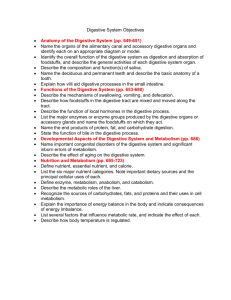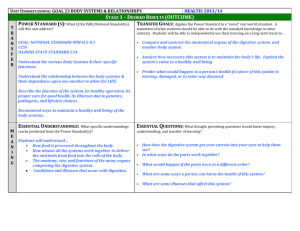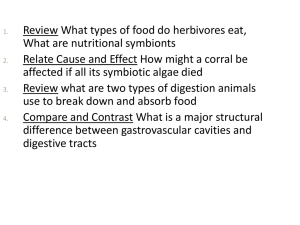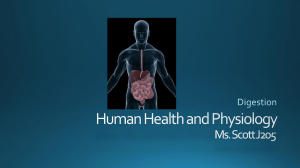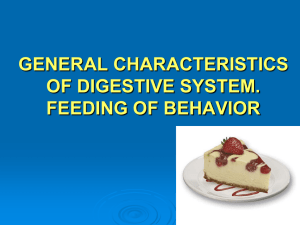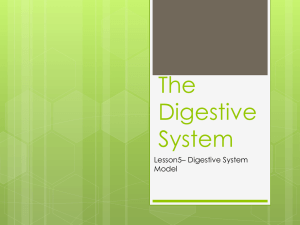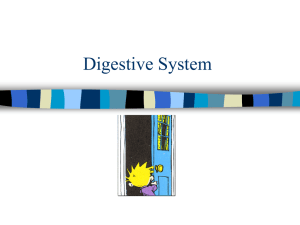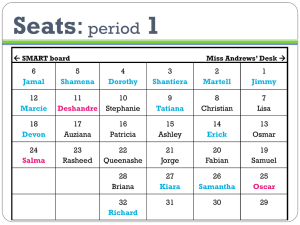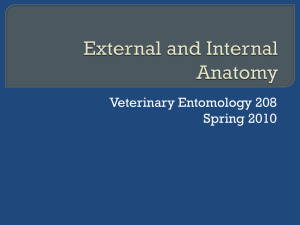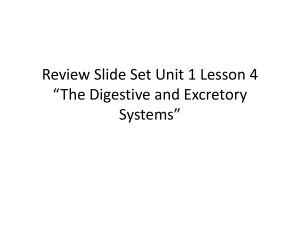Concept Presentation - Digestion
advertisement
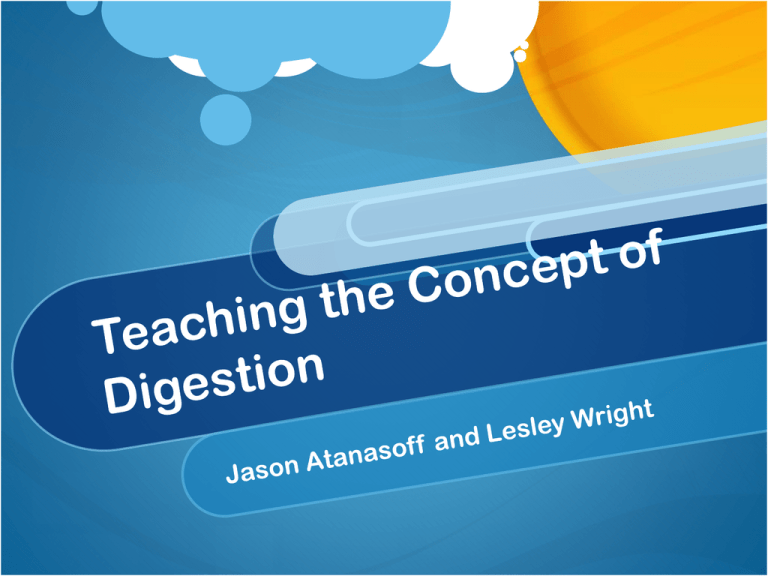
Background Information All cells require energy; Energy to the cells must come from the food we eat Energy from food is converted into ATP, which is a useable energy source for cells The digestive system works by several organs working together to break down food Each type of food we eat has different nutritional values Background Information Organs included in the digestive system are the mouth, esophagus, stomach, duodenum, small intestine, large intestine, colon, and anus Digestive system is a long tube that spans the entire body Digestive system connects to a multitude of other organ systems Overview of the Digestive System Lesson Sequence Lesson #1: Introduction to the Digestive System In this lesson, students will be introduced to the concept of the digestion system. Brainstorming activity – functions and organs Create their own labeling diagram of organs and functions Lesson Sequence Lesson #2: Organ Overview In this lesson, students will go into more depth about the different organs “One long tube” demonstration Students will create their own analogy Lesson Sequence Lesson #3: Fluids in the Digestive System & Physical and Chemical Digestion In this lesson, students will learn about the different fluids in the digestive system as well as physical vs. chemical digestion Teacher demonstration of physical vs. chemical digestion Students will complete chart of where and how each type of food (protein, fat, carbohydrates) are broken down Lesson Sequence Lesson #4: Accessory Organs In this lesson, students will learn about the accessory organs to the digestive system Learning stations in 4 corners Students will complete a chart based on the research that they do during the learning stations activities Lesson Sequence Lesson #5: Other Systems that Connect In this lesson, students will learn about the other organ systems that have the biggest connections to the digestive system Ball and string activity Students will complete mind map Lesson Sequence Lesson #6: Presentation of Digestive Sequence In this lesson students will present their organ with respect to the digestive system Students will present in a multiple intelligence format to engage students Tennis ball pass Peer assessment Lesson Sequence Lesson #6: Test The test will be a more detailed version of the labeling activity done in the first lesson Label organs, functions, what is digested there, and a problem associated with it Curriculum Expectations Overall: D3 – Demonstrate an understanding of chemical components of and energy in food, and the processes by which food is digested Specific: D3.1 – describe the basic chemical components of proteins, carbohydrates, fats, and lipids, and vitamins and minerals, and explain their functions in the body D3.4 – describe the structure and function of the components of the digestive system with respect to physical and chemical digestion Central Idea Digestive system organs Physical vs. Chemical Digestion, and what is involved with that Interconnectedness of Organ Systems Digestive system as a continuous tube Teaching Style Hands-on activities Multiple intelligences Demonstrations Group work Potential difficulties Idea of where blood flows – students might not know how many blood vessels are centered about the digestive system Concept of food being “inside” the body – Since the digestive system is a continuous tube, food never “enters” the body, it is only passing through Interconnectedness– Students might not see how other organ systems work with the digestive system Potential Solutions! Idea of where blood flows – Have students incorporate this concept into their initial mind map in Lesson #1, have students colour or write in words where blood flows around the digestive system, use analogies to explain Concept of food being “inside” the body – Explain using the doughnut analogy, and relate food being inside the digestive track like you hold a stick in your hand – it is not inside you, you are around it Potential Solutions! Interconnectedness – using the ball and string activity will help to show students how each system relates to the other Safety Using proper safety equipment during physical vs. chemical digestion – safety glasses, no eating, no horseplay, etc. Using general proper safety techniques in the classroom during all activities Applications Healthy eating – relating the next lessons to crash diets, fad diets, and eating disorders Removing types of food for allergies and sensitivities Chemical additives in food – are they needed? This can lead into a debate about the pros and cons of non-nutritive food additives Differentiated Assessment Lesson #1 – Assessment AS learning – students will self assess their background knowledge of the digestive system by highlighting and circling Lesson #2 – Assessment FOR learning – students will exchange analogies with a peer to get feedback and fill in gaps in their understanding Differentiated Assessment Lesson #3 – Assessment OF learning – teacher will assess the accuracy of their food digestion tables Lesson #4 – Assessment OF learning – teacher will assess their accessory organ chart for accuracy, and classroom participation Differentiated Assessment Lesson #5 – Assessment FOR learning – teacher will assess the students’ mind map for the number of connections, presentation, and accuracy. They will use this to study for the test Lesson #6 – Assessment FOR learning – peers will complete a peer feedback form on the students presentations, based on information, engagement, and areas for improvement Differentiated Assessment Lesson #6 – Assessment OF learning – teacher will have students write a test based on organs, their functions, what is digested there, and problems with that organ
